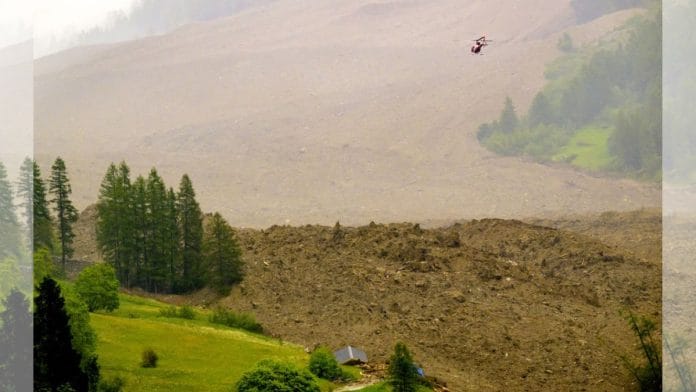New Delhi: A massive glacier collapse on Wednesday buried most of the Swiss village of Blatten, with one person missing and the entire village destroyed, the BBC reported.
Most of the village’s 300 inhabitants had been evacuated the previous week because of fears the Birch glacier was disintegrating.
“The extent of the damage to Blatten had no precedent in the Swiss Alps in the current or previous century,” Christian Huggel, professor of environment at the University of Zurich, told Reuters.
Blatten is a mountain village that was located in southern Switzerland at the foot of the Birch Glacier, in a valley surrounded by the Bernese Alps.
A drone image shared by Swiss President Karin Keller-Sutter shows the entire village, the Lonza river that runs through it and the surrounding landscapes buried in mud.
Es ist schlimm, wenn man seine Heimat verliert. Ich fühle in diesen Stunden mit den Bewohnerinnen und Bewohnern von Blatten. pic.twitter.com/BArZbIAQSn
— Karin Keller-Sutter (@keller_sutter) May 28, 2025
“I feel for the people of Blatten, no one should have to lose their home like this,” the President said in a post on social media platform X.
The Swiss government, according to the BBC, has already arranged funds to resettle residents in the village or in nearby localities. But about 90 percent of Blatten has been destroyed, and threats of another landslide and further damage remain.
Melting glaciers in Switzerland
Switzerland, roughly the size of Haryana, is home to more than 1,800 glaciers, the highest number in Europe.
The glaciers are not just critical to the ecosystem but also central to tourism in Switzerland, with several ski slopes operating on them.
However, Swiss glaciers have lost 40 percent of their original volume since 2000, according to the Swiss Academy of Sciences.
Swiss climate authorities like the Swiss Academy of Sciences have been repeatedly warning about the rapid melting of glaciers in the European country since 2006.
According to a study by the academy, 10 percent of the country’s glacier volume melted between 2022 and 2023 because of extremely high temperatures in the summer and low snow accumulation in winter.
“Glaciers are the ambassadors of climate change. They make it very clear what is happening out there because they respond in a very sensitive way to warming temperatures,” said Matthias Huss, the head of Glacier Monitoring Switzerland (GLAMOS), in a statement to AP.
ETH Zurich professor Daniel Farinotti said in an interview with ETH News in March that if global warming is not contained, Switzerland would lose all its glaciers by 2100.
He explained that glacier melting leads to natural hazards like floods and landslides, but in the long run, it will also cause problems like water shortages and hydroelectric power issues.
Like Blatten, other mountain villages in the Swiss Alps, like Brienz, have earlier faced evacuation orders because of the threat of landslides and rockslides. Thawing ice, unseasonal rain and heat linked to climate change make the rocks on the side of the mountain unsteady, the BBC reported.
How to prevent glacier melt?
The Swiss government has used the process of covering glaciers with white geotextiles to prevent melting since 2006.
This artificial process of slowing down glacier melt has been useful in a local context, according to a paper in Science Direct, but its impact has been limited.
“However, interventions of this kind are very expensive and cannot be scaled up in size. You cannot save entire glaciers by doing this,” said Farinotti in his March interview. “Reducing our greenhouse gas emissions is the only effective and sustainable way to protect global glacier melt.”
(Edited by Sugita Katyal)
Also Read: The ‘urban heat island’ phenomenon: Why some parts of Delhi are hotter than others






